
21 minute read
Technologies to Enhance Synthetic Lubricating Greases
Technologies to ENHANCE
Gareth Fish, PhD CLS CLGS and Chris Hsu, PhD
Abstract
According to the 2014 NLGI Annual Grease Production Survey, synthetic base fluid greases now account for approximately 5% of the total grease market with semisynthetics making an additional 2.5%. The majority of greases (up to 80%) made with synthetic oils use polyalphaolefins (PAO) as the main component of their base oil. In terms of oxidative and thermal stability, they have outstanding properties but they have some significant negatives being seemingly less shear stable and bleed oil more readily than the mineral oil equivalents. One further challenges for PAOs is that they respond differently to chemical additives. Packages that work well in Group I and Group II mineral oils often struggle to perform in PAO and other synthetic based greases.
Synthetic esters offer the potential to be both biodegradable and renewable, depending on what alcohols and acids are used to synthesize the esters. Synthetic diesters esters typically have low viscosities and need to be boosted with polymers and or complex esters.
Fully Synthetic calcium sulfonate and calcium sulfonate complex greases are growing, albeit at a slower rate than calcium sulfonates in general. They offer significantly improved low temperature properties and pumpability compared to mineral oil based products.
Other fluids such polyalkylene or polypropylene glycol base fluids are now more in demand as they are one of the three base oil types proposed as part of the vessel general permit (VGP) legislation.
More exotic fluids such as silicone oils, alkylated diphenyl ethers (ADE), perfluoropolyether (PFPE) and ionic fluids (IF) greases can also be used to manufacture synthetic greases, but again thickener and additive response is different. The challenge for these types of fluids that they all have negative properties which need to be counteracted with additives.
The above outlined issues will be discussed in detail and potential solutions to formulating fully synthetic greases offered.
Introduction
According to the 2014 NLGI Annual Grease Production Survey (1), synthetic base fluid greases now account for approximately 5% of the total grease market with semisynthetics making an additional 2.5%. Between 2010, when the base oil type was first recorded, the volume of fully synthetic greases has grown from 25,000 tons to a reported 40,000 tons in 2014. The volumes of many of the specialty synthetic fluids sold are very small. This paper will look at issues surrounding the formulation and development of lubricating greases in a variety of synthetic fluids.
Polyalphaolefin thickened greases
The majority of greases (up to 80%) made with synthetic oils use polyalphaolefins (PAO) as the main component of their base oil. In terms of oxidative and thermal stability they have outstanding properties but they have some significant negatives for grease. One challenge to the grease formulator as the thickener content need to make an NLGI #2 grease is typically 50% higher than for a naphthenic mineral oil of similar viscosity (2). Despite the higher soap content, PAO greases are seemingly less shear stable and bleed oil more readily than the mineral oil equivalents. If being used in sealed bearing applications, seal swell agents need to be added to the PAO grease.
A study was carried out to investigate manufacturing influences on the thickening and dropping points of PAO based synthetic lithium complex greases. Lithium complex
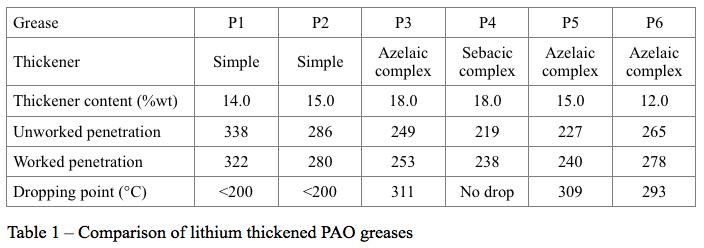
greases are typically manufactured in one of two ways: two-step or onestep (2).
Traditionally a two-step process has been used. There is an initial saponification with the thickening acid, normally 12-hydroxystearic acid, followed by a second saponification or reaction with the complexing agent. If a dicarboxylic acid, such as azelaic or sebacic acid is used, the two-step process should reliably produce high dropping points in the range of 260 °C to 280 °C. A variation on this is when a boron source, such as boric acid or borate ester, is used as the complexing agent. If using boric acid mixed with water, it is reacted into the grease in a similar way to the complexing dicarboxylic acid. When using a borate ester or other oil soluble boron source, it is typically added during the cooling down phase after the batch has cooled to below 150 °C. It is however important that the boron source is added above 110 °C to enable it to be properly incorporated into the matrix of the grease. This boron-based approach to complexing will produce dropping points in the range of 260 °C to 300 °C, but this depends on how much boron is added. Comparing their thermal stability, synthetic simple lithium greases will work satisfactorily to about 130 °C. Borated complexes will work above these temperatures, but lower than the 160 °C that low acid ratio complexes will perform up to (2).
In a one-step process, the complexing and thickening acids are melted and saponified together. If lithium hydroxide in water is used as the lithium source, the complexing process is difficult to control and can result in good thickening but with scattered dropping points. A series of PAO-based greases were manufactured using either lithium hydroxide in water or an anhydrous lithium hydroxide dispersion. The fatty acid sources were either neat 12-hydroxystearic acid or its methyl ester. The complexing acid was either sebacic or azelaic acids or their dimethyl esters. Reactions were carried out in open, closed and pressurized reactors. Saponification was carried out at 90 °C for either 30, 60 or 90 minutes. FTIR Spectra were taken of the finished greases and the amount of free alkalinity determined by a modified in-house version of ASTM D128. Saponifying the lithium hydroxide in water for only 30 minutes did not run any reactions to completion. The greases were very soft. Free acid and methyl esters were detected in the greases by Fourier transform infrared (FTIR) spectroscopy. When saponifying for 60 or 90 minutes complete reaction was seen with the thickening acid or methyl ester. Neither the azelaic nor sebacic acid reacted well at 90 °C, giving greases with low dropping points. The dimethyl esters did react completely with the lithium hydroxide when saponified for 90 minutes, but the greases had scattered dropping points ranging from 200 °C to 250 °C, indicating poor complexing reactions had taken place. Similarly, when reacted under pressure with the methyl esters, the lithium hydroxide in water produced a high yield grease with a worked penetration of 200 but a dropping point of only 210 °C. The anhydrous lithium dispersion reacted satisfactorily with acids but not very well with the methyl esters, even when reacted for 90 minutes.
Many grease customers now require lithium complex greases to have dropping points >280 °C and typically in the case of fully synthetic greases >300 °C. In 2014 (3), it was reported that the only way to consistently achieve dropping points of >300 °C was to use the anhydrous lithium hydroxide dispersion. Some greases were prepared in 100% PAO using this technology. The data is included in Table 1. Similar simple lithium and lithium complexes greases were made in group I paraffinic mineral oils. The thickener content for the simple lithium was 7% for an NLGI #2 and for the azelaic lithium complex was 9%. Table 1 further illustrates the higher soap contents necessary for the 100% PAO synthetic greases.
Bleed reducers for PAO based greases
Two new polymers were obtained, which claimed better bleed reduction properties than the typical styrene-isoprene polymers in mineral oil based greases. They were incorporated into a fully synthetic PAO grease with a base oil viscosity of 6 mm2/s at 100 °C. The greases were tested for ASTM D6184 oil bleed at 150 °C and the results of these tests are shown in table 3.
One further challenge for PAOs is that they respond differently to chemical additives. Packages that work well in


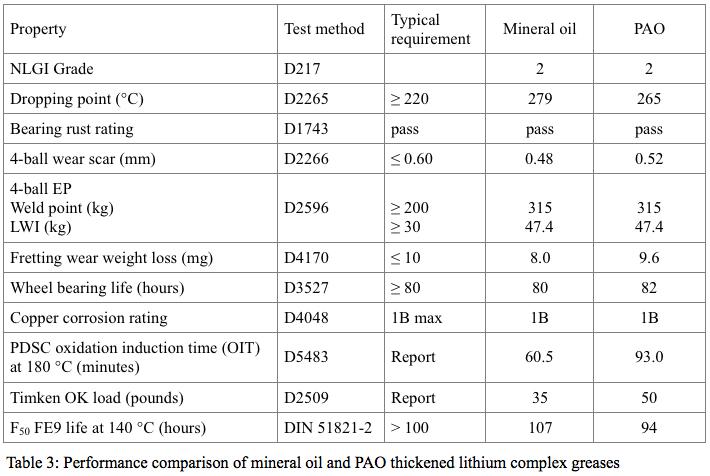
Group I and Group II mineral oils often struggle to perform in PAO based greases. Two sebacate lithium complex greases were manufactured with lithium hydroxide monohydrate using ISO VG 150 base fluids. One utilized a mineral oil blend of Group II paraffinic oil and Group I paraffinic bright stock and the other was a blend of PAO 6 and 100. A standard zinc containing EP additive package was incorporated into the grease. Salient GC-LB grease performance tests carried out, along with some additional tests, such as pressure differential scanning calorimetry (PDSC) and these are reported in table 3. Both greases passed the requirements of the NLGI ASTM D4950 GC-LB standard, but there were some noticeable differences in performance.
The other significant observation was the different greases failure modes seen in the wheel bearing grease life test. The mineral oil grease failed by lacquering up the bearing so that after meeting the 80 hour minimum, it would not restart after the cooling phase. The PAO based grease was observed to have failed because the grease structure had broken down and as the bearings are installed vertically, the grease had leaked out. There was a steady increase in torque as the grease seemed to leak out of the bearings. Unusually, the PAO grease failed by over-torqueing during running and not at start up after the 4 hour stationary phase.
A further comparison of mineral oil and PAO base fluids was carried out looking at two different viscosity grades and thickeners. Again the wheel bearing grease life test was used to compare the behavior of greases. The results in table 4 are not statistically significant, but again the failure modes matched what had been seen earlier with the mineral oil greases creating lacquer and the PAO based ones bleeding out.
Further work is ongoing which has shown that if the bleed and stability can be controlled by polymers then the grease will give longer life. A structurally modified version of the PAO grease in table 4 was tested recently and gave an FE9 F50 of 150 hours at 140 °C. Post-test analysis of the used grease was carried out and showed degradation of the thickener. Increasing the level of anti-oxidants present in the grease was also seen to be beneficial, as it seemed to better protect the thickener from degradation. A further comparison of urea thickened synthetic fluid greases is now underway.
Greases in synthetic esters
Synthetic esters are the second largest family of synthetic fluids used as the lubricating base for grease. These fluids have significantly better properties than naturally derived esters, which are typically low viscosity fluids, have poor oxidation and thermal stability (4) and need to be boosted with hydrocarbon polymers, complex and polymer esters to achieve the required viscosities of base fluids for good lubricating properties.
In 2014, Fish and Hsu (3) reported that making thickeners directly in synthetic esters was problematic. Historically, it was only possible to use inorganic thickeners such as clays or silica or pre-formed simple calcium or lithium soaps using to thicken these types of oils. Preformed calcium anhydrous (12-hydroxystearate) soaps will give grease dropping points of 140 to 160 °C and those of pre-formed lithium stearate or 12-hydroxystearate will give grease dropping points of 180 to 200 °C. To develop good grease properties, the pre-formed


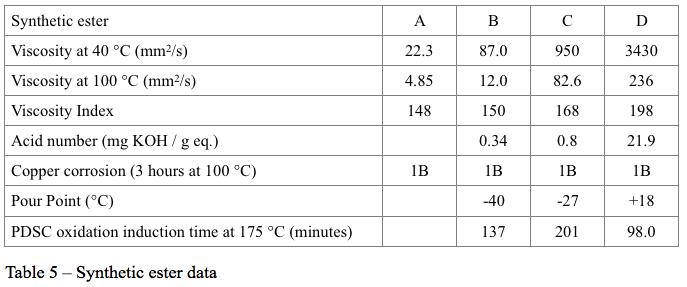
thickeners, still have to be heated to melt the soap and are not readily available as complexes. As in mineral oils, clay thickened esters do not have a dropping point and silica thickened grease have higher degradation temperatures than simple soap thickened greases. Adding a clay thickener that does not give a dropping point to an easily oxidized and thermally unstable does not make it into a higher temperature capable grease (2).
In 2015 Fish (4), reported that the manufacturing process utilizing anhydrous lithium hydroxide dispersions had been further developed. The technology was able to deliver not only simple lithium greases in synthetic and natural esters but more importantly high temperature lithium complex thickened greases with dropping points >300 °C. The small particle size (<10 µm) of the lithium hydroxide in the dispersion allows it to react very quickly with the thickener acid and the complexing acid if present. The only water present is from the saponification reaction and it is easily removed with minimal hydrolysis of the base oil. This also minimizes the foaming associated with the water removal. Further development of the anhydrous lithium hydroxide dispersion manufacturing process showed that it was the only viable option to make high quality greases in sensitive base oils was to use anhydrous lithium dispersions.
Ten different synthetic ester base fluids were procured from four different suppliers. The typical properties were determined and compared. Some of the original esters were found to have compatibility issues. Two others were identified as having supply issues and the list was reduced to the more manageable number of four. The basic properties of those four fluids are listed in table 5.
The kinematic viscosities of a series of blends of these fluids were calculated targeting at ISO VG 100, ISO VG 150 and ISO VG 220. These blends were, checked for compatibility and miscibility. Then the viscosities were determined at 40 °C and 100 °C. As reported in 2015 (4), some of the early blends produced hazy mixtures and these were discarded. In table 6, the fluid ratios of the successful blends are reported along with their determined viscosity data and calculated viscosity indices.
The process used to manufacture these greases was the revised version outlined in 2014 (5). The fluid blend is mixed and heated up to 70 °C, then the complexing acid is added. It is then heated to its melting / oil solublization temperature. In the case of azelaic acid, the melting temperature is 101 °C and in the case of sebacic acid the temperature is 135 °C. The 12-hydroxystearic acid is added and it absorbs heat from the batch and on melting cools the mixture to the desired 85 °C to 90 °C required for the complex saponification. At a 2:1 acid ratio, the thickener delivers dropping points >300 °C, but it requires a higher thickener content. Dilithium sebacate also enhances the rust inhibition of the grease. Despite its higher melting temperature and slightly more difficult processing, sebacic acid was selected as the complexing agent at a 3:1 acid ratio.
A styrene-isoprene polymer to enhance water resistance and tackiness was also cooked into the base grease at a 2%wt treat rate. This polymer was selected because it has very good shear stability and unlike most of the typical polymers used in grease, it is readily soluble in synthetic ester base fluids. Base greases were manufactured using the base fluid blend oils listed in table 5. The greases were made slightly stiff so that they could be cut back to an NLGI grade 2 using the corresponding base fluid blend.
A standard anti-oxidant, extreme pressure (EP) / anti-wear (AW) performance package (4) that also included rust and
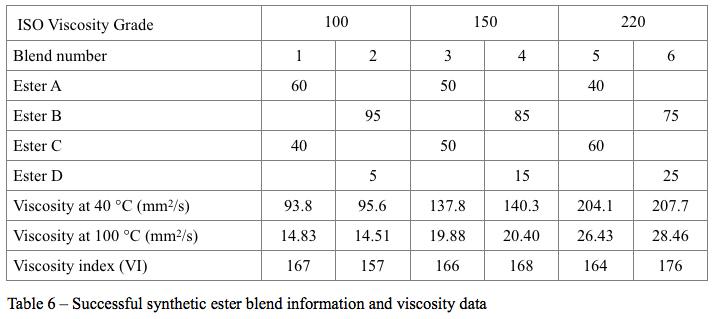
corrosion inhibitors was also incorporated into the grease. The properties of the fully formulated greases are included in table 7. As can be seen from this data, the lithium complex thickener delivered high dropping points. The styrene-isoprene polymer delivered excellent water resistance and the performance package delivered satisfactory EP and AW performance.
Fully synthetic calcium sulfonate greases

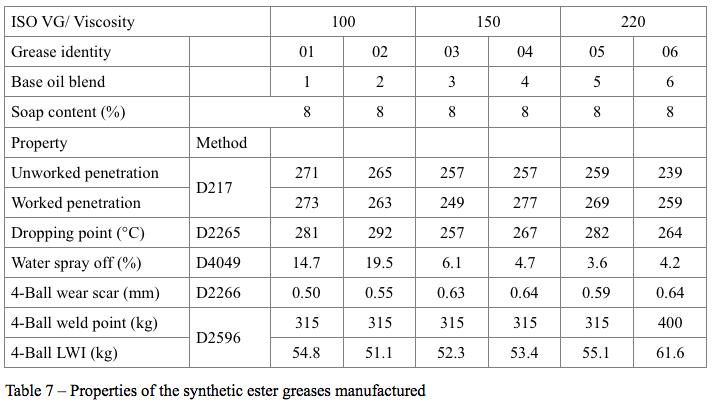
Fully Synthetic calcium sulfonate and calcium sulfonate complex greases are growing albeit at a slower rate than calcium sulfonates in general. They offer significantly improved low temperature properties and pumpability compared to mineral oil based products.
It is relatively easy to manufacture a fully synthetic calcium sulfonate grease. The process was described in detail (5). It starts with mixing a synthetic base fluid with a 400TBN overbased sulfonate in PAO 6 at around 50 °C, followed by the addition of a suitable organic or sulfonic acid. Acetic acid is added slowly to the mixture. The amount of acid added to destabilize the micellular structure of the sulfonate depends on the amount of free lime present in the overbased calcium sulfonate. Water and alcohol are added and the mixture is heated it to the gelation temperature. It is held at that temperature until the complete conversion of the calcium carbonate from amorphous to calcite has occurred. For industrial synthetic sulfonates, there are no significant restrictions on what acids or alcohols can be used to aid gelling speed and improve the gel strength. A batch of grease was made in a laboratory kettle using a blend of PAO 6 and PAO 100 as the base oil. The blend gave a final base oil viscosity grade ISO 68. An industrial grade of alkylbenzenesulfonic acid was used along with acetic acid. A promoter and water were also added and the grease gelled in 3 hours. This was followed by stripping at 150 °C. A second grease was made in a resin flask, this time using polyisobutylene (PIB) instead of the PAO as the viscosity fortifier. By increasing the acetic acid quantity to a small excess over normal and keeping the amount of sulfonic acid and promoter constant, the gelling time was reduced from 3 hours to 45 minutes. The results of both greases are reported in the table 8 below. Both greases were made without additional additives.
Two types of synthetic calcium sulfonate complex greases have been developed. The first used a two-step process in which the sulfonate is first gelled and then 12-hydroxystearic acid, more lime and water are added. The mixture is heated and held until the saponification reaction is completed before the last of the water is stripped out and the penetration is adjusted to meet the target value.
A single step process was developed in which the 12-hydroxystearic acid is added up front with the synthetic base fluid, the calcium sulfonate, and the sulfonic acid. These are mixed together and followed by the addition of water and the promoter alcohol or glycol. The mixture is heated to the gelation temperature and held until both saponification and calcium carbonate conversion reactions have run to completion, before stripping out the water and promoter. Both of these two events can be monitored by FTIR spectroscopy. It is also important that the equivalents of the acids and the bases
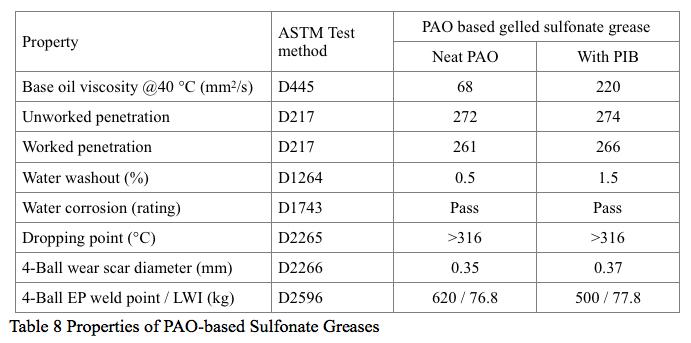

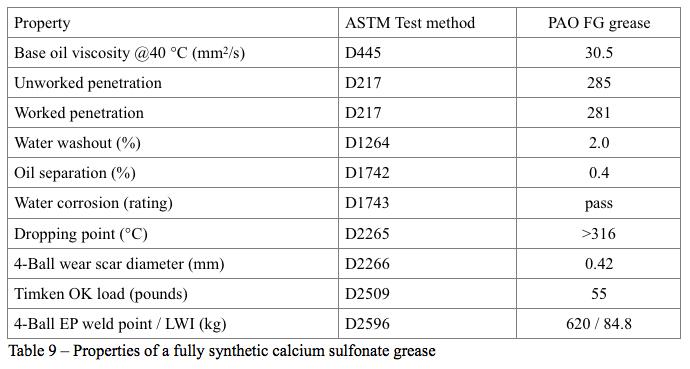
used are known and that the batch remains within an optimum window of basicity. If the batch has too high a level of free basicity then this will prevent or stall the calcium carbonate conversion and the batch may not process properly. If the mixture is too close to neutrality or has insufficient free basicity, they is a tendency for the conversion to become unstable and the carbonate will be converted to the undesired form of vaterite rather than calcite.
H1 incidental food contact grade fully synthetic calcium sulfonates can also be manufactured from HX-1 registered components including the 400TBN sulfonate and sulfonic acid. Some of the best acids for aiding gelation and stiffening are not approved for food grade use. The calcium salts of some acids are approved, and one of these acids needs to be chosen for use as the gelation aid. Building on what was learned about gelling with the industrial sulfonate, a process was developed to gel the sulfonate in PAO 6. A laboratory kettle batch of grease was made using an HX-1 registered 400TBN calcium sulfonate in PAO 6, food grade promoter and water, acetic and sulfonic acids, and using a blend of PAO 6 and food grade registered PIB. The data in Table 9 shows the resulting food grade grease without additional additives has good properties.
Other Synthetic fluids
The challenge for formulators working with any of the more unusual base fluids is that there is little openly published data. It is common knowledge (2) how much simple lithium soap thickener is needed to make an NLGI #2 in a quality naphthenic base oil with a 40 °C viscosity of 150 mm2/s. Guidelines to achieve required levels of EP or AW properties using additives are widely available. With many synthetic fluids, the only way to generate data is to manufacture base greases, incorporate additives and test the performance of the finished grease.
Other fluids such as polyethylene or polypropylene glycol base fluids are now more in demand as they are one of the three base oil types proposed as part of the vessel general permit (VGP) legislation. Formulating greases with glycols requires a different approach to that of mineral oil based greases.
More exotic fluids such as silicone oils, polyethers, perfluoropolyether (PFPE) and ionic fluids can also be used to manufacture synthetic greases, but the thickener and the additive responses are different. The challenge for these types of fluids that they all have negative properties which need to be counteracted with additives. Ionic fluids can be corrosive and it is necessary to ensure that when making grease, additional alkali is added to the saponification to neutralize the free base fluid acidity.
An alkylated diphenyl ether (ADE) fluid with a 40 °C kinematic viscosity of 100 mm2/s was obtained to do thickening and additive studies. These types of fluids are used to formulate special greases for rolling element bearings. The typical thickener used for this type of fluid is a diurea.
A sample of base grease was manufactured using this ADE base fluid with a diurea thickener based on the reaction of stearylamine (SA) with methylene bis-diphenyl diisocyanate (MDI). The grease needed to be stiffer than normal to allow for softening when the additive package was incorporated and so the thickener content was targeted at 18%. A second base grease was made using aniline, cyclohexylamine (CHA), and MDI. This second grease was too soft and so a third base grease was made with the thickener content increased to 20.2%. The data is in table 10.
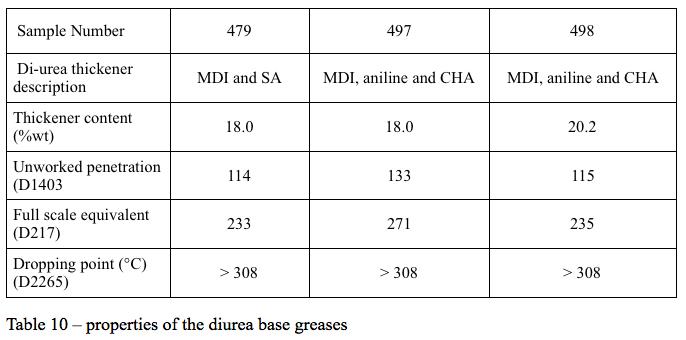

Two different zinc containing additive packages as previously described (6) were incorporated into the 479 and 498 base greases. The first package which treated at 4% did not show any significant softening of the 479 base grease but did in the 498 base grease. The second package with a higher treat rate, caused significant softening of both base greases. It also showed significant softening when adding gelled calcium sulfonate as a co-thickener into both bases. It was therefore decided that the MDI, aniline, and CHA thickener system need more development and so it was not investigated further at this stage. Two finished greases based on the 479 base with the first zinc package (#23) and with one containing the gelled calcium sulfonate (#22) were finished and tested. The results of this testing are in table 11.
The presence of the gelled calcium sulfonate co-thickener boosted the EP and anti-fretting wear properties of grease #22 over #23. Overall, the wheel bearing grease life obtained at over 400 hours are outstanding results as are the very long grease lives at 177 °C in the D3336 Pope test.
References
(1) Grease Production Survey Report 2014, NLGI, 249 SW
Noel, Suite 249, Lee’s Summit, MO 64063 (www.NLGI. org)
(2) NLGI Grease Guide, 6th Edition (2015), NLGI, 249 SW
Noel, Suite 249, Lee’s Summit, MO 64063 (www.NLGI. org)
(3) Fish, G. and Hsu, C., “Technology to Improve the Grease
Making Process”, presented at the NLGI 81st Annual
Meeting, PGA National Resort, Palm Beach Gardens,
Florida, June 2014
(4) Fish, G., “The Development of More Environmentally
Considerate Greases” presented at the NLGI 82nd Annual
Meeting, Coeur d’Alene Resort, Coeur d’Alene, ID, June 2015
(5) Fish, G. and Ward Jr, W.C. “Calcium Sulfonate Greases
Revisited” presented at the NLGI 78th Annual Meeting,
Desert Palm, California, June, 2011
(6) Fish, G., Ward Jr, W.C., and Capitosti S.M. “Grease
Additives for High Temperature Bearing Applications” presented at the ELGI 26th Annual General Meeting, 26th -29th April 2014, Dubrovnik, Croatia
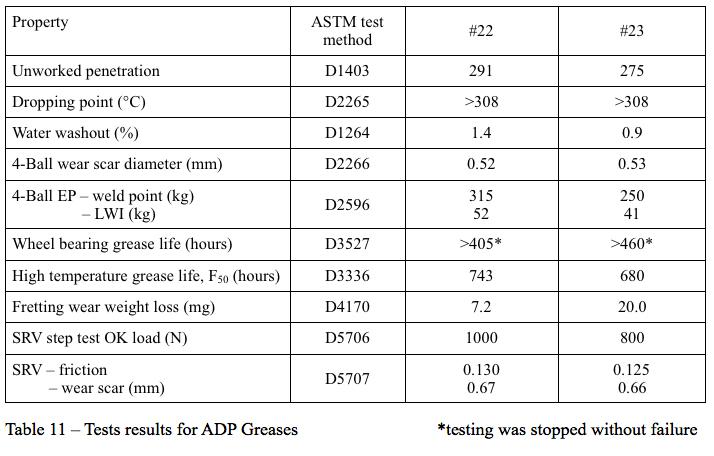
Conclusions
It has been shown above that the formulation know-how and manufacturing technology is available to develop fully synthetic greases in a wide variety of base fluids and with different thickeners.
Formulations and packages developed for mineral oil based greases do not respond in the same way as they do in fully synthetic greases.
Fully synthetic calcium sulfonate and calcium sulfonate complexes have been manufactured and have be shown to have very good properties.
The use of an alkylated diphenyl ether as a base fluid was shown to give long life grease when thickened with an MDISA diurea. Adding a gelled calcium sulfonate as a co-thickener improved the final grease properties.
Acknowledgements
The authors wish to acknowledge many co-workers and departments within The Lubrizol Corporation for their contributions to this work.
NLGI SPOKESMAN
Be featured in NLGI Member Spotlight!

All NLGI members may take advantage of this opportunity to highlight your company’s history, global reach, vision, employees or whatever you’d like our readership to know about your company. You may talk about products & services, however, no competitor trade names may be used, nor mention of product pricing.
There is no limit on words and we welcome many photos of your headquarters, offices, plant & employee photos. We will accept articles for publication on a first received, first published basis. Contact Kim Hartley kim@nlgi.org at NLGI if you would like to submit an article for possible publication in an upcoming issue.




